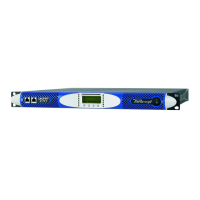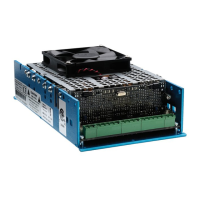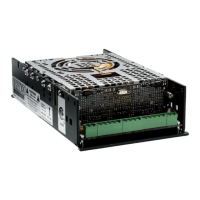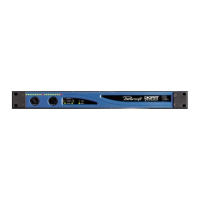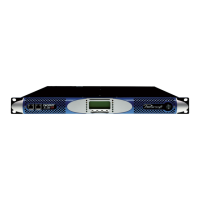▶
34
Duecanali User Guide
stored internally and available to remote clients connected to the
amplier. The load impedance is indirectly inferred by successive
approximations. Time between single output impedance
approximations depends on the output signal: the greater the
amplitude of the signal, the shorter the time interval between
measurements needed to approximate the output impedance,
the faster the successive approximation method will converge to
the true impedance value.
back
Zload=8.0 C1+2
70 Vrms
9 Arms
630 Watt
FIGURE 55: Output meters screen for a bridged channel 1/channel
2 connection. Measured load impedance in this example is 8 Ohms.
11. 2 Temperature
This screen displays the current amplier temperature.
back - +
34°C
FIGURE 56: Current amplier temperature
11. 3 Mains meters
This screen displays the updated mains RMS voltage and RMS
current levels. Values are displayed in numbers and as progress
bars.
Mains meters
back
170 Vrms
20 Arms
FIGURE 57: Updated mains RMS current and voltage values
PLEASE NOTE: the current and voltage levels displayed in this
screen are approximate values: which serve the purpose of giving
▶
AES3-B: the AES3-B stream coming from one of the two
RJ45 ports
10.5.2 Source Mode
This menu allows to selects the channel(s) contained the selected
AES stream to be forwarded to the output power stage of the
amplier. The possibilities are:
▶
Parallel from L: the left channel from the selected AES3
stream (see “8.2.1.1 Source Selection” on page 21) is
forwarded to both amplier channels
▶
Parallel from R: the right channel from the selected AES3
stream (see “8.2.1.1 Source Selection” on page 21) is
forwarded to both amplier channels
▶
Stereo: the right channel from the selected AES3 stream goes
to channel 1 or the amplier; the right channel from the AES3
stream goes to the amplier’s left channel.
10.5.3 Gain Trim
This parameter trims the digital level of the AES3 stream. The gain
trim scale goes from +5dB to -40dB with 0.5dB steps. The 0dB
gain trim level has an analog level equivalent of +13.5dBu. A 0dBFS
level in the AES3 stream corresponds to an absolute analog level
of +18.5dBu (with a +5dB gain trim level).
Note: please note that when using a digital input, the amplier
will keep a xed 32dB gain.
10.5.4 If no link
This parameter allows the user to choose the behavior of the
amplier when the digital audio stream is missing and the Input
Selection is set as KAESOP=>OUT. The two possible alternatives
are:
▶
Mute: in this case the amplier output is muted
▶
Analog: in this case the amplier automatically switches
to CH1/CH2 analog input if the digital stream is missing,
returning to the digital stream in case this should become
available again. This mode could be used to implement an
analog backup connection for the digital stream.
11 Display
11.1 Output Meters
The output meters screen shows important output signal
information for the amplier. By pressing the right most front panel
button, the screen view is toggled between information relative to
channel 1, channel 2 or relative to the sum of channels 1 and 2
3
.
The top line in this screen displays the RMS voltage value of the
output, both as a number as well as a horizontal meter bar. The
second and third line display the output RMS current and power
level respectively. The output power reported is a peak value
reading taken every 200 ms. The bottom line of the screen displays
the load impedance as “Zload”. The minimum output voltage is
3
Note: in the “C1+2” mode, the RMS voltage and power readings
displayed are the average RMS voltage and peak power of each
channel. The RMS current value, on the other hand, is the sum of
each single channel’s RMS current level.
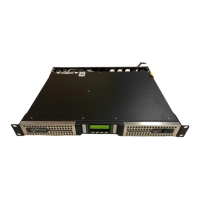
